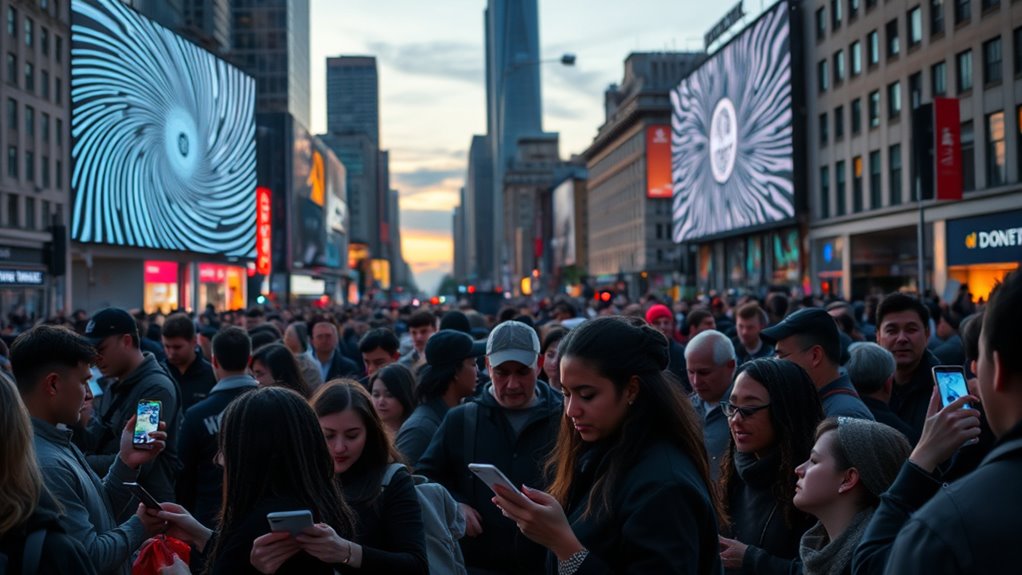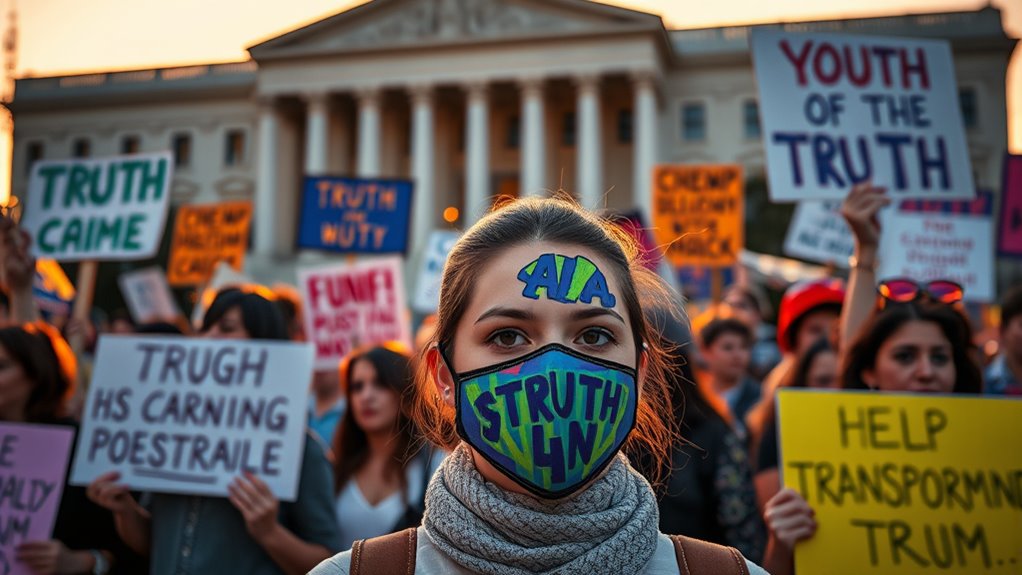To safeguard democracy against AI-driven disinformation, you should prioritize media literacy and critical evaluation skills. Stay informed about sophisticated false content like deepfakes and bot networks, and support policies that demand transparency and regulation of AI-generated material. Getting involved in community initiatives and advocating for technological safeguards can strengthen defenses. By understanding these tactics, you empower yourself and others to challenge manipulation. If you want to learn more about protecting democracy from these threats, keep exploring these essential strategies.
Key Takeaways
- Implement robust policies requiring transparency and labeling of AI-generated content to prevent manipulation.
- Enhance media literacy education to empower citizens in critically evaluating digital information.
- Develop advanced detection tools to identify deepfakes and bot networks spreading disinformation.
- Promote community engagement initiatives to raise awareness and collective resistance against false narratives.
- Foster collaboration between governments, tech companies, and civil society to establish accountability and safeguard democratic processes.

Democracy is not a given; it requires ongoing effort and vigilance to protect. One of the most effective ways you can defend it is by sharpening your media literacy skills. In an age where AI-driven disinformation spreads rapidly, understanding how to critically evaluate information is essential. Media literacy empowers you to identify false narratives, recognize manipulated content, and distinguish credible sources from unreliable ones. As disinformation becomes more sophisticated with AI tools, developing a skeptical eye and questioning the origin and intent behind the information you encounter helps prevent falling for manipulation. It’s not just about consuming content but actively engaging with it, asking questions about its authenticity, and cross-referencing with multiple trusted sources.
In addition to personal vigilance, supporting and advocating for policy regulation is indispensable. Governments and institutions must implement rules that hold social media platforms and content creators accountable for the spread of false information. Effective policy regulation can set standards for transparency, requiring platforms to label or remove AI-generated disinformation. It should also promote the development of tools that detect and counteract deepfake videos, bot networks, and other AI-driven content designed to mislead. When you push for sensible policies, you help create an environment where misinformation is less likely to flourish and where the integrity of democratic processes is protected. These regulations serve as a safeguard against the unchecked proliferation of falsehoods that can sway elections, polarize communities, and undermine trust in institutions. Additionally, understanding the technical aspects of home theatre projectors, such as contrast ratio and color accuracy, can help you better evaluate the quality of visual content and recognize potential distortions or manipulations in media. Developing a broader awareness of digital information and how it can be manipulated is crucial for maintaining an informed citizenry, especially as deepfake technology advances.
However, policy regulation alone isn’t enough. You need to be proactive in understanding the policies in place and supporting initiatives that promote media literacy education. Encourage your community, schools, and workplaces to prioritize media literacy training, so everyone can navigate the complex digital landscape safely. When more people are educated about how disinformation works and how policies aim to curb it, it creates a collective resistance to manipulation. This shared responsibility helps reinforce democratic resilience, making it harder for malicious actors to exploit information gaps. Recognizing the role of cybersecurity vulnerabilities in the spread of disinformation underscores the importance of strengthening digital defenses. Developing critical thinking skills and understanding the types of cookies used on websites can also help you be more aware of data collection practices that may be exploited for targeted disinformation campaigns.
Ultimately, safeguarding democracy in the face of AI-driven disinformation demands a dual approach: enhancing your media literacy and backing strong policy regulation. You have a role to play in scrutinizing content critically and advocating for rules that limit the spread of falsehoods. By doing so, you contribute to a more informed citizenry and a healthier, more resilient democracy. It’s an ongoing effort that requires your active participation, vigilance, and commitment to truth in a digital age where misinformation can spread faster than ever before.
Frequently Asked Questions
How Can Individuals Identify Ai-Generated Disinformation?
When you’re trying to spot AI-generated disinformation, focus on visual cues like unnatural pixelation or inconsistent lighting. Always verify the source by checking its credibility and cross-referencing with trusted outlets. Be skeptical of sensational headlines or unusual formatting. By paying attention to these visual cues and doing source verification, you can better identify fake content and avoid spreading false information. Stay vigilant and question what you see online.
What Legal Measures Exist Against Ai-Driven Disinformation Campaigns?
Oh, because clearly, AI disinformation campaigns just need a gentle warning and a friendly hug, right? In reality, legal frameworks and regulatory policies are in place to combat this menace. Countries are crafting laws to hold creators accountable and prevent misuse. You can expect stricter regulations, penalties for malicious actors, and ongoing international cooperation. These measures aim to protect you from falling prey to falsehoods, ensuring democracy stays intact amid technological chaos.
How Do Social Media Platforms Combat Ai-Generated Fake Content?
You can see that social media platforms combat AI-generated fake content by employing advanced deepfake detection tools and content moderation algorithms. These technologies analyze videos, images, and text for signs of manipulation, helping to identify and remove false information quickly. By continuously updating these systems, platforms stay ahead of AI technology, reducing the spread of disinformation and protecting users from misleading content.
What Role Do Educational Programs Play in Disinformation Prevention?
Think of educational programs as the sturdy lighthouse guiding you safely through foggy waters of disinformation. They teach you media literacy and critical thinking, helping you spot fake content and false claims. By strengthening these skills, you become less likely to fall for AI-generated disinformation. You’re empowered to navigate the digital sea with confidence, making smarter choices and protecting your understanding of truth amid the waves of misinformation.
How Can International Cooperation Enhance Disinformation Defenses?
International cooperation can bolster disinformation defenses through strong global alliances and effective information sharing. By working together, you can quickly identify and respond to AI-driven disinformation campaigns, minimizing their impact. Sharing intelligence, best practices, and technological tools among countries helps create a united front. This collaboration ensures you stay ahead of evolving tactics, making it harder for disinformation to spread unchecked across borders.
Conclusion
You stand at a crossroads, like a lighthouse guiding ships through a stormy sea of disinformation. Just as a lighthouse keeps sailors safe, your vigilance and action protect democracy’s integrity. Remember, in 2022, AI-generated deepfakes fooled millions, showing how easily truth can be distorted. But with awareness and effort, you can be the beacon that shines clarity, guiding others toward truth and safeguarding the foundation of our democracy.









